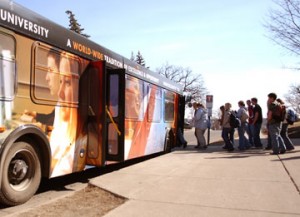
By John Addison (2/25/09)
American’s rise to tough challenges. This recession is hitting people hard. Transportation is 20 percent, or more, of many people’s expenses. American’s are finding smart ways to save. Public transportation use is at its highest in over 50 years. Commute program participation is breaking records. Americans drove 100 billion fewer miles in 2008 than the previous year.
A study by the American Automobile Association (AAA) shows that the average cost of owning and operating a passenger vehicle is 54.1 cents per mile. This is over $8,000 per year per vehicle, based on 15,000 miles of driving. Depreciation is part of that cost. Anyone who has bought a car for $20,000 and later sold it for $5,000 understands depreciation. Fuel, maintenance, tolls, parking, financing, and insurance add up. Most U.S. households have two vehicles, costing them over $16,000 per year.
The opportunity to save on transportation costs depends on many factors: living in the city or suburbs, household size, number of kids, type of work, and feasibility of car sharing.
A friend of mine is getting hit hard with vehicle costs and by being in an industry that is in a downward spiral. He and his wife are refinancing the home to stay above water. Their family of five includes four vehicles – primarily SUVs and a pick-up truck. When their youngest turns 16 this year, my friend is planning to get his son his own car. Vehicle number 5. At first glance, it looks like they have no other choice. Like most suburbs, frequent public transit is not in walking distance. Everyone is busy with work, school, sports, and community activity.
A closer look shows that this family could save over $10,000 per year. The three teenagers/young adults could share one or two vehicles. They live two-miles from a main street where public transit is reasonably frequent. All are great athletes who could bike to and from transit. Transit includes express buses during morning and evening commute hours that connect to a major downtown, other transit systems, rail, colleges, and more.
No one likes to deal with conflicts with teenagers and vehicle sharing is sure to create some conflict, yet communication and conflict resolution are important lessons for teenagers to learn. Family members might surprise you in creating sharing solutions that work, especially when bike and transit options are there. Taking the bus or biking to and from high school is not the end of the world. A young adult that insists on having their own vehicle can take the responsibility of working part time to pay for the vehicle, insurance, and fuel.
For years, Mark and Lisa Williams shared one vehicle. Both Mark and Lisa commuted during similar work hours from Elk Groove to Sacramento. They rode to work together. By riding together they saved up to an hour daily by using the HOV lane for vehicles with two or more passengers.
They also saved the $1,740 per year that would be necessary to pay for two Sacramento parking spaces instead of one. Mark and Lisa were not always able to commute together. When their jobs were miles apart, Lisa would take Mark to the nearby light rail that transported him to Sacramento. The Williams, including their son, never ceased to find irony as the three of them in one vehicle drove past the three vehicles parked in the driveway of a single neighbor.
When their teenage son approached driving age, the Williams bought a second vehicle, a Toyota Prius. Most of the time, the three rode together, leaving their SUV in the garage. When someone was going in an opposite direction, then the second vehicle is used. After seven months, they we’re using the SUV so little that they could not justify the cost of keeping it. They are back to a one-car family which works for the three of them. On rare occasions, the SUV is missed. Mark says, “It does require some compromises, like borrowing a vehicle when we want to use our kayaks, but it is well worth it, and will only become more so as gas prices slowly start climbing again.”
When I talk with people aged 14 to 30, I am surprised by how many do not want a car. My niece Lindsay Short was given the family’s 2001 Prius when she graduated high school with honors. She leaves the car with her parents and lives car free at the university. Like many universities, anything is faster going from class to class than trying to drive and search for the impossible parking space. On campus transit, bicycling, and walking work best. When cars are needed, car sharing services such as Zipcar, offer qualified students aged 18 and older, vehicles by the hour. What many students need is a monthly allowance that is a fraction of the cost of car ownership, so that they can pay for car sharing, public transportation, and trips home to see family. As an environmentalist, Lindsay wants to be true to her values.
You do not need to be in school to make a difference. For everyone, from those who live alone, to roommates, to families, transportation costs can be cut with flexwork, commute programs, public transit, and car sharing.
During his February 24 Address to Joint Session of Congress, President Obama stated, “The only way this century will be another American century is if we confront at last the price of our dependence on oil… That is our responsibility.”
Millions of Americans are responding to the current challenge of being financially secure; they are also addressing the need to provide their children with a future that is energy secure and climate secure. People are riding clean, riding together, and riding less.
